
Stylophora pistillata, commonly known as hood coral or smooth cauliflower coral, is a species of stony coral in the family Pocilloporidae. It is native to the Indo-Pacific region and is commonly used in scientific investigations.
Acanthastrea rotundoflora is a species of coral found in Indo-Pacific waters from the Red Sea to Australia and the East China Sea. The species in uncommon throughout its range, and is threatened by the global loss of coral reef habitats.

The branch coral is a species of acroporid coral found in the southwest and northern Indian Ocean, the central Indo-Pacific, Australia, Southeast Asia, Japan and the East China Sea, Cook Islands and the oceanic west Pacific Ocean. It can be found in shallow reefs on the reef tops, walls and slopes to depths of 30 m.

Turbinaria stellulata, also known as disc coral, is a species of colonial stony coral in the family Dendrophylliidae. It is native to the Indo-Pacific region. The International Union for Conservation of Nature has rated its conservation status as being "vulnerable".

Turbinaria mesenterina, commonly known as disc coral, is a species of colonial stony coral in the family Dendrophylliidae. It is native to the Indo-Pacific region. The International Union for Conservation of Nature has rated its conservation status as being "vulnerable".

Turbinaria peltata, commonly known as disc coral, is a species of colonial stony coral in the family Dendrophylliidae. It is native to the Indo-Pacific region. The International Union for Conservation of Nature has rated its conservation status as being "vulnerable".

Turbinaria frondens, commonly known as disc coral, is a species of colonial stony coral in the family Dendrophylliidae. It is native to the Indo-Pacific region. It is a zooxanthellate coral that houses symbiont dinoflagellates in its tissues.
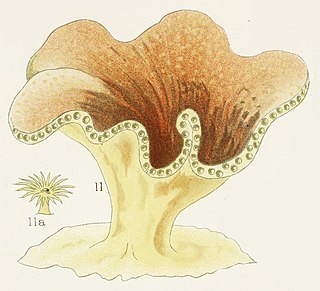
Turbinaria patula, commonly known as disc coral, is a species of colonial stony coral in the family Dendrophylliidae. It is native to the Indo-Pacific region, being found in the eastern Indian Ocean, northern Australia, the South China Sea and the western Pacific Ocean. It is a zooxanthellate coral that houses symbiont dinoflagellates in its tissues. It is an uncommon species and the International Union for Conservation of Nature (IUCN) has rated it as a "vulnerable" species.
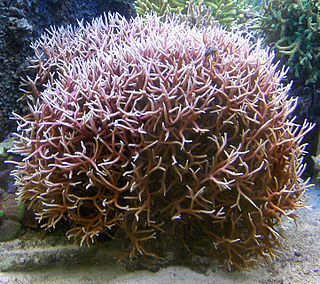
Seriatopora hystrix is a species of colonial stony coral in the family Pocilloporidae. It forms a branching clump and is commonly known as thin birdsnest coral. It grows in shallow water on fore-reef slopes or in sheltered lagoons, the type locality being the Red Sea. It is native to East Africa, the Red Sea and the western Indo-Pacific region. It is a common species and the International Union for Conservation of Nature has assessed its conservation status as being of "least concern".
Seriatopora aculeata is a species of colonial stony coral in the family Pocilloporidae. It forms a bushy clump. It is native to the Central Indo-Pacific and the Oceanic West Pacific. Its range includes the Philippines, the Great Barrier Reef, Fiji, Indonesia, the Coral Sea, southern Madagascar and Vanuatu. It grows in shallow reef environments, at depths down to about 40 metres (130 ft). It is an uncommon species and subject to coral diseases and bleaching. The International Union for Conservation of Nature has assessed the conservation status of this species as being "vulnerable".
Seriatopora guttata is a species of colonial stony coral in the family Pocilloporidae. It is native to the western Indo-Pacific region, its range extending from Madagascar and the Indian Ocean to the central Indo-Pacific, Australia, Indonesia and the south China Sea. It grows in shallow water on sheltered reef slopes, on vertical walls and under overhangs, at depths down to about 40 metres (130 ft). It is a common species and the International Union for Conservation of Nature has assessed its conservation status as being of "least concern".
Seriatopora stellata is a species of colonial stony coral in the family Pocilloporidae. It is native to the western Indo-Pacific region, its range extending from the central Indian Ocean to the central Indo-Pacific, northwestern Australia, Indonesia, Japan, the south China Sea and the oceanic island groups in the West Pacific. It grows in shallow water on sheltered reef slopes at depths down to about 20 metres (66 ft). It is a widespread but uncommon species and the International Union for Conservation of Nature has assessed its conservation status as being "near threatened".
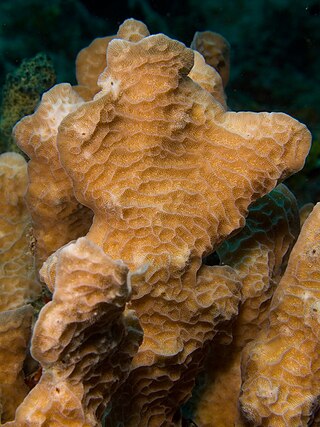
Agaricia agaricites, commonly known as lettuce coral or tan lettuce-leaf coral, is a species of colonial stony corals in the family Agariciidae. This coral is found in shallow waters in the tropical western Atlantic Ocean and the Caribbean Sea. The IUCN has assessed its status as being Vulnerable.
Acropora abrolhosensis is a species of acroporid coral that was first described by John Veron in 1985. Found in sheltered lagoons and shallow reefs, it is listed as a vulnerable species on the IUCN Red List. The population of the species is decreasing, and most specimens are found in Western Australia, but occurs in many other areas. It is also listed under CITES Appendix II.

Oulophyllia crispa, sometimes called the intermediate valley coral, is a species of stony coral in the family Merulinidae. It is native to the tropical western and central Indo-Pacific region. Although this coral has a wide range, it is generally uncommon and seems to be decreasing in abundance, and the International Union for Conservation of Nature has rated its conservation status as being "near threatened".
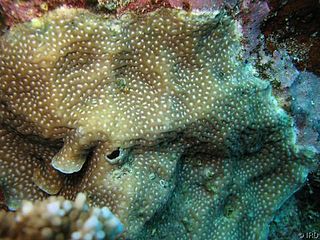
Pavona bipartita, sometimes known as leaf coral, is a species of colonial stony coral in the family Agariciidae. It is found in shallow water, on reef slopes and on vertical surfaces, in tropical parts of the western and central Indo-Pacific region.

Pavona decussata, sometimes known as leaf coral, is a species of colonial stony coral in the family Agariciidae. It is found in shallow water in various reef habitats, particularly on gently sloping surfaces, in tropical parts of the western and central Indo-Pacific region.

Blastomussa merleti, commonly known as pineapple coral, is a species of large polyp stony coral. It is unclear in which family the genus Blastomussa belongs. This coral is native to the west and central Indo-Pacific region and is sometimes used in reef aquaria.
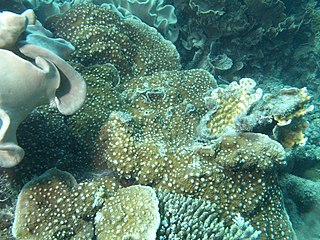
Oxypora lacera, the ragged chalice coral or porous lettuce coral, is a species of large polyp stony corals in the family Lobophylliidae. It is a colonial coral which can be submassive, encrusting or laminar. It is native to the western Indo-Pacific.
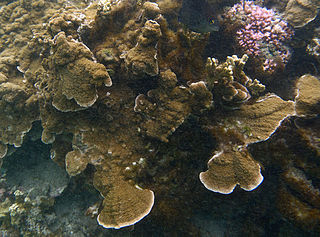
Echinophyllia aspera, commonly known as the chalice coral, is a species of large polyp stony corals in the family Lobophylliidae. It is a colonial coral which is partly encrusting and partly forms laminate plates or tiers. It is native to the western and central Indo-Pacific.

















